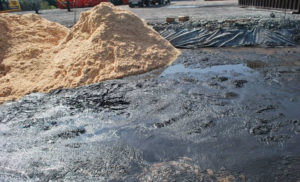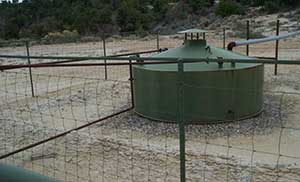On May 9, 2008, the New Mexico’s Oil Conservation Division (OCD) signed the final version of the oil and gas waste pit rule. The rule is one of the strongest in the country.
The pit rule won broad support from suburban landowners, ranchers, and residents across New Mexico who have suffered water and soil contamination from unlined oil and gas waste pits and buried waste.
Why the pit rule is needed
Between the mid-1980s and 2003, the OCD’s Environmental Bureau recorded nearly 7,000 cases of pits causing soil and water contamination.
The OCD released data in 2005 showing that close to 400 incidents of groundwater contamination had been documented from oil and gas pits.
State sampling showed carcinogens in all pit samples and heavy metals in two-thirds of the pit samples. Citizen groups, ranchers and landowners from throughout New Mexico are understandably quite concerned about water quality, exposure to unknown levels of toxic chemicals, stock and wildlife deaths, and a broad range of other issues facing residents who live near oil and gas sites.
What the pit rule does
Under the pit rule:
- unlined pits (see photo above) are banned;
- pit liner requirements are strengthened;
- pit construction must better protect private property and water resources;
- closed loop (i.e. pitless) operations are required when close to water resources and home; and
- all pits must be permitted with the Oil Conservation Division;
- a public inventory of pits is required.
A likely consequence of the rule: industry saving money in the long run by moving to closed-loop (pitless) systems. Mary Ellen Denomy, Petroleum Accountant, told the Oil Conservation Commission that closed-loop systems saved 3% per well. Denomy stated that companies were able to cut costs on construction, water, drilling muds and waste disposal when utilizing closed-loop systems.
The pit rule under attack
Ever since the pit rule was enacted, industry, and their champions in state government, have been fighting to have it weakened.
They have been unsuccessful to date.
However, they are still trying.
Defending the pit rule
Earthworks’ Oil & Gas Accountability Project has partnered with the New Mexico Environmental Law Center to defend the pit rule in court. Because the facts are clearly on our side, we have a good chance to preserve the pit rule from legal attacks.However, with an industry-friendly Governor in place — and her task force targeting the pit rule for removal — the pit rule needs political defense as well.
New Mexicans, you can help defend the pit rule from political attack:
Write a letter to the editor of your local paper.
Tell your story. Personal accounts of the negative impacts of oil and gas drilling resonate with the public, the media, and representatives. If you’d like to tell your story — either in print or in video or both — contact us.
Support Earthworks’ Oil & Gas Accountability Project with a donation. Fighting industry’s lawyers/lobbyists/PR machine costs money. $5 or $500, it all helps.
For More Information
- Earthworks: The New Mexico Pit Rule: good questions and honest answers. Fact sheet
- Earthworks: The New Mexico Pit Rule: true economics. Fact sheet
- ProPublica: Drilling Industry and Gubernatorial Candidates Move to Weaken Some State Regulations, August 5, 2010.



